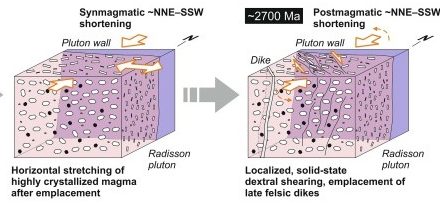
Late Archean magmatism and the onset of modern-style plate tectonics
The timing of and processes related to the onset of modern-style plate tectonics have long been vigorously debated. We have started multidisciplinary research into Late Archean TTG suites (tonalite–trondhjemite–granodiorite), which may provide the key information on the complex and protracted transition from vertically-dominated plume tectonics that operated on Early Earth to plate tectonics that we see today.
Key papers
Svojtka M, Žák J, Kachlík V, Ackerman L, Tomek F, Vacek F, Sláma J (2024) Late Archean sedimentary basins in the northeastern Superior Province, Canada: plume-generated crustal tears or syn-convergent accretionary belts? Precambrian Research 406: 107386
Žák J, Svojtka M, Sláma J, Tomek F, Kachlík V, Ackerman L, Vacek F, Trubač J (2023) Exploring the link between spatiotemporal patterns of plutonism and geodynamic regimes at the end of Archean: an example from the northeastern Superior Province, Canada. Precambrian Research 392: 107073
Žák J, Tomek F, Svojtka M, Vacek F, Kachlík V, Ackerman L, Ježek J, Petronis MS (2021) Distributed crustal shortening followed by transpressional shearing in the Superior Province, northeastern Canada: a Late Archean analogy to modern accretionary plate margins? Precambrian Research 362: 106322
Tectonic setting of granitoid plutons in arcs and collisional orogens
Using a combination of structural analysis and geochronology, whole-rock and isotopic geochemistry, and gravimetry, we examine plutons as temporal and strain markers of regional deformation. Our present work concentrates on general issues of fabric development in plutons in response to regional strain, interactions of magma mingling, flow, and emplacement with regional tectonics, and spatial and temporal changes in plutonism during evolution of orogenic belts.
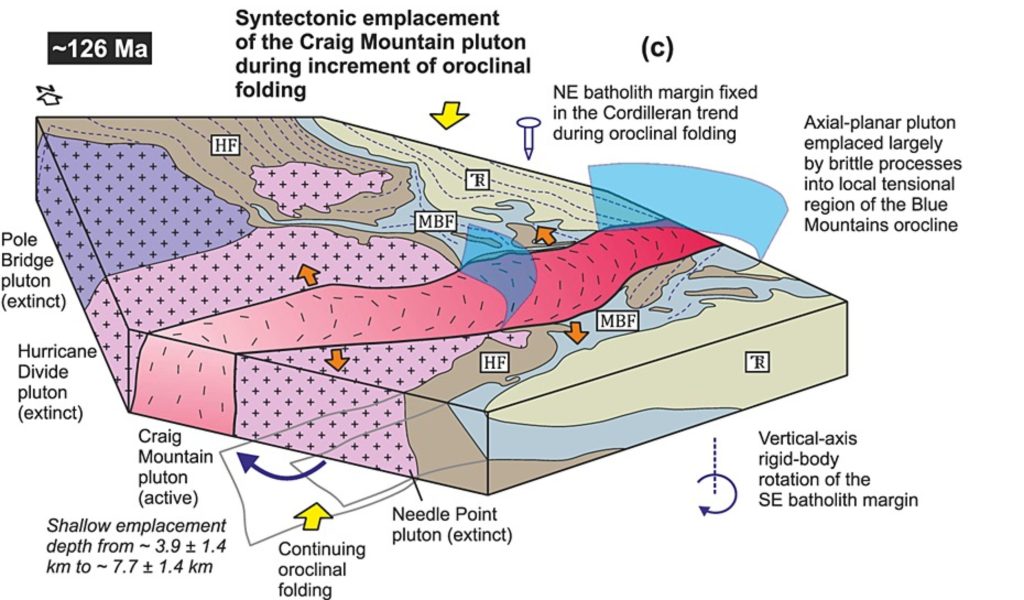
Key papers
Tomek F, Žák J, Verner K, Ježek J, Paterson SR (2024) A complex interplay between pluton emplacement, tectonic deformation, and plate kinematics in the Cretaceous Sierra Nevada magmatic arc, California. Tectonics 43: e2023TC007822
Syahputra R, Žák J, Tomek F, Kachlík V (2023) Hot plutonism in a cold accretionary wedge: what terminated the Cadomian orogeny at the northern periphery of Gondwana? Precambrian Research 390: 107041
Trubač J, Žák J, Kondrová L (2020) Magmatic tempos in large hot orogens in comparison with continental margin arcs Journal of Geology 128: 465–475
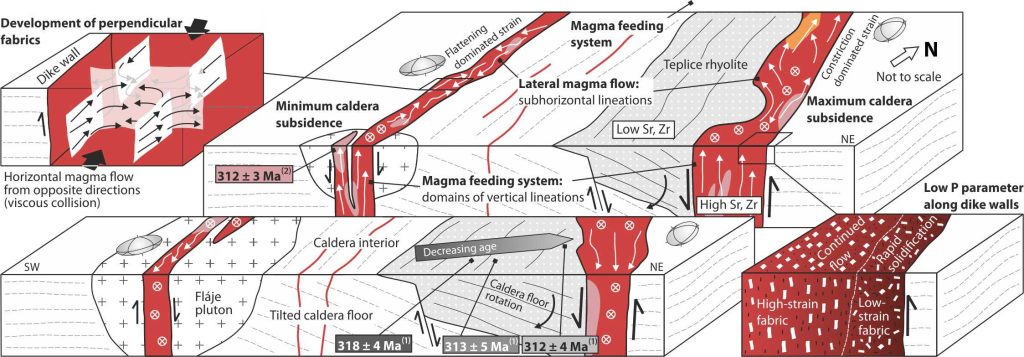
Magma flow and strain patterns in volcano–plutonic systems
Volcano–plutonic connection and mechanical processes in and above shallow-level magma chambers still remain poorly understood. Our research has recently concentrated on magma flow patterns in subcaldera plutons, mechanisms of growth and strain patterns in andesite domes, magma flow in both ring and radial dikes associated with collapse calderas, and internal fabric and emplacement of ignimbrite sheets
Key papers
Tomek F, Olšanská I, Trubač J, Černý J, Rejšek J, Ackerman L (2023) On the anatomy and structural control of a dyke swarm that fed caldera-forming ignimbrite eruptions. Journal of the Geological Society 180: jgs2022-119
Tomek F, Opluštil S, Svojtka M, Špillar V, Rapprich V, Míková J (2022) Altenberg–Teplice Caldera sourced Westphalian fall tuffs in the central and western Bohemian Carboniferous basins (eastern Variscan belt) International Geology Review 64: 441–468
Tomek F, Žák J, Verner K, Holub FV, Sláma J, Paterson SR, Memeti V (2017) Mineral fabrics in high-level intrusions recording crustal strain and volcano-tectonic interactions: the Shellenbarger pluton, Sierra Nevada, California Journal of the Geological Society, London 174: 193–208
Dynamics of Precambrian accretionary wedges
One of the main goals of our research is to better understand how Precambrian accretionary wedges formed and evolved along convergent plate margins. Based on structural analysis, anisotropy of magnetic susceptibility, geochemistry, and geochronology, we examine mechanisms of sediment accretion, internal strains, formation of ophiolitic mélanges, and late-stage extension in ancient accretionary wedges and compare those processes with modern settings.
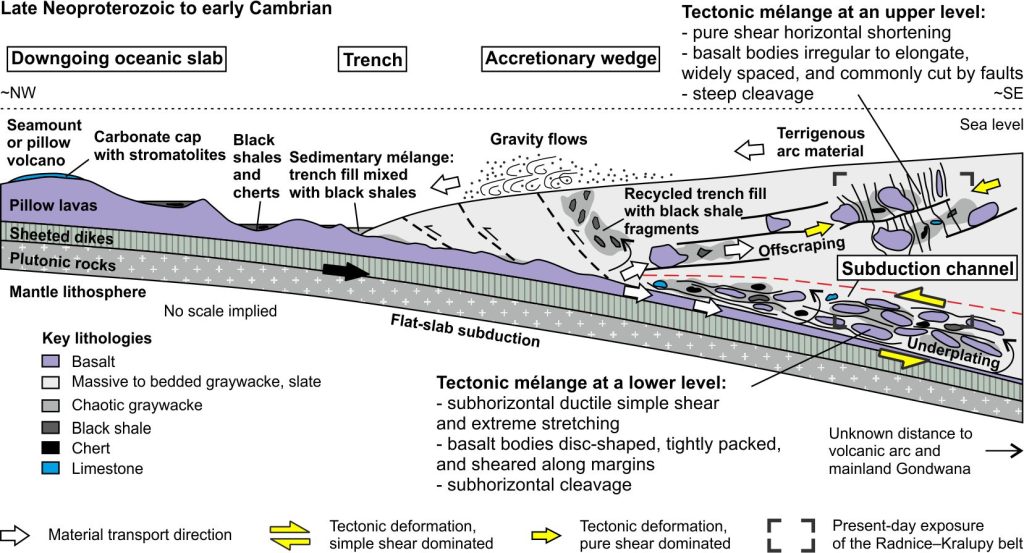
Key papers
Pellerey L, Žák J, Tomek F, Festa A (2024) Magnetic fabric of OPS mélanges: a tool for unravelling protracted histories of oceanic plates from sea-floor spreading to tectonic emplacement into accretionary wedges. Journal of the Geological Society 181: jgs2023-141
Žák J, Sláma J, Syahputra R, Nance RD (2023) Dynamics of Cambro–Ordovician rifting of the northern margin of Gondwana as revealed by the timing of subsidence and magmatism in rift-related basins. International Geology Review 65: 3004–3027
Ackerman K, Žák J, Kachlík V, Pašava J, Žák K, Pack A, Veselovský F, Strnad L (2023) The significance of cherts as markers of Ocean Plate Stratigraphy and paleoenvironmental conditions: New insights from the Neoproterozoic–Cambrian Blovice accretionary wedge, Bohemian Massif. Geoscience Frontiers 14: 101478
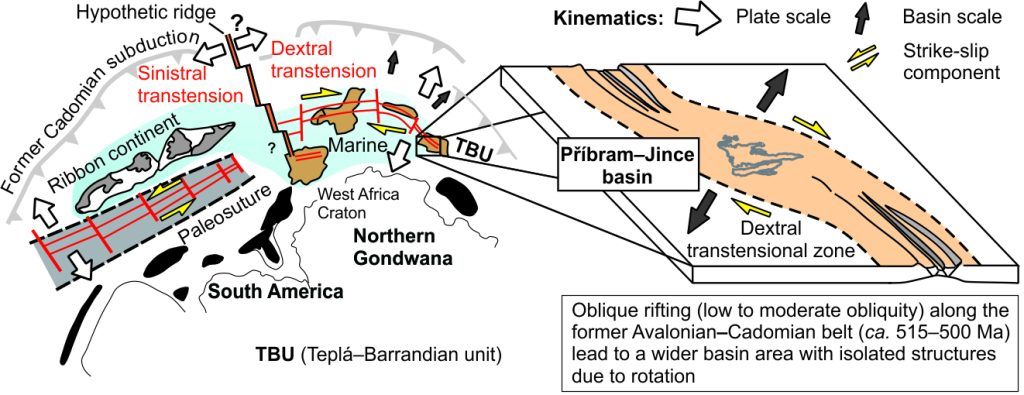
Tectonics of sedimentary basins in collisional orogens
One of the main goals of our research is to better understand how Precambrian accretionary wedges formed and evolved along convergent plate margins. Based on Development of orogenic sedimentary basins reflects a complex interaction among brittle faulting, tectonically-controlled uplift, erosion, and deposition. Our ongoing research is targeted on mechanisms of basin inversion in response to shortening of orogenic upper crust, initiation and tectonics of intracontinental basins during orogenic collapse, and relations between paleotopography, exhumation, and basin development.
Key papers
Žák J, Sláma J, Syahputra R, Nance RD (2023) Dynamics of Cambro–Ordovician rifting of the northern margin of Gondwana as revealed by the timing of subsidence and magmatism in rift-related basins. International Geology Review 65: 3004–3027
Syahputra R, Žák J, Nance RD (2022) Cambrian sedimentary basins of northern Gondwana as geodynamic markers of incipient opening of the Rheic Ocean Gondwana Research 150: 492–513
Tomek F, Vacek F, Žák J, Petronis MS, Verner K, Foucher MS (2019) Polykinematic foreland basins initiated during orthogonal convergence and terminated by orogen-oblique strike-slip faulting: an example from the northeastern Variscan belt Tectonophysics 766: 379–397
Application of rock-magnetic methods in solving geologic problems
We employ anisotropy of magnetic susceptibility and other rock-magnetic methods to analyze a wide range of geologic processes, including granitic magma emplacement and deformation, magma flow in dikes, growth of volcanic domes, formation and exhumation of metamorphic core complexes, and basin development during regional extension.
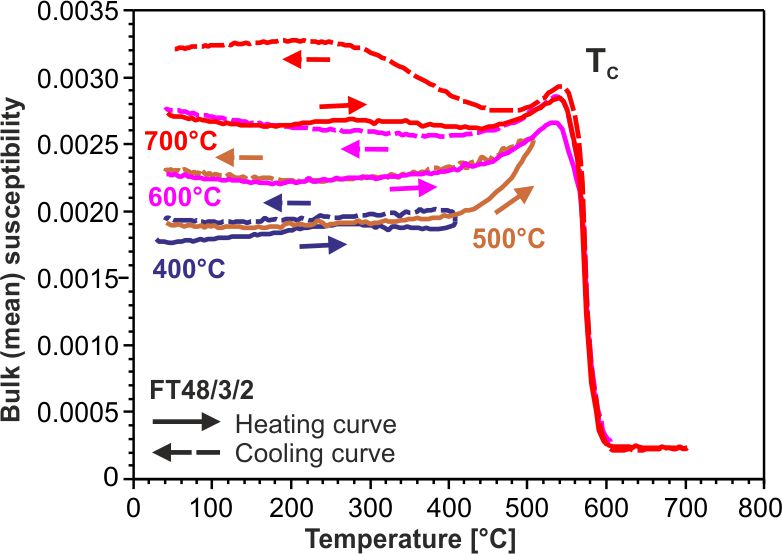
Key papers
Olšanská I, Tomek F, Chadima M, Foucher MS, Petronis MS (2024) Magnetic multi-fabrics as tools for understanding ignimbrite emplacement processes: an example from late-Variscan Tharandter Wald Caldera, Bohemian Massif. Journal of Structural Geology 178: 105012
Vitouš P, Tomek F, Petronis MS (2022) Magnetic fabrics of rhyolite ignimbrites reveal complex emplacement dynamics of pyroclastic density currents, an example from the Altenberg–Teplice Caldera, Bohemian Massif. Bulletin of Volcanology 84: 75
Žák J, Verner K, Ježek J, Trubač J (2019) Complex mid-crustal flow within a growing granite– migmatite dome: an example from the Variscan belt illustrated by the anisotropy of magnetic susceptibility and fabric modeling Geological Journal 54: 3681–3699

Application of continuum mechanics in understanding magmatic processes
Our joint research with the group of Prof. Petr Kabele, Department of Mechanics, Czech Technical University in Prague, utilizes high-end computational facilities to integrate numerical models with geologic data and observations. Our ongoing research targets include modeling of mineral fabric development in magmatic rocks in 3D, cooling of magma bodies, granitoid diapirism, and formation of collapse calderas.
Key papers
Somr M, Žák J, Kabele P, Tomek F (2023) Analysis of fracturing processes leading to caldera collapse.
Earth-Science Reviews 241: 104413
Kabele P, Žák J, Somr M (2017) Finite element modeling of magma chamber–host rock interactions prior to caldera collapse Geophysical Journal International 209: 1851–1865
Trubač J, Janoušek V, Žák J, Somr M, Kabele P, Švancara J, Gerdes A, Žáčková E (2017) Origin of reverse compositional and textural zoning in granite plutons by localized thermal overturn of stratified magma chambers Lithos 277: 315–336